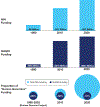Strategic vision for improving human health at The Forefront of Genomics
- PMID: 33116284
- PMCID: PMC7869889
- DOI: 10.1038/s41586-020-2817-4
Strategic vision for improving human health at The Forefront of Genomics
Abstract
Starting with the launch of the Human Genome Project three decades ago, and continuing after its completion in 2003, genomics has progressively come to have a central and catalytic role in basic and translational research. In addition, studies increasingly demonstrate how genomic information can be effectively used in clinical care. In the future, the anticipated advances in technology development, biological insights, and clinical applications (among others) will lead to more widespread integration of genomics into almost all areas of biomedical research, the adoption of genomics into mainstream medical and public-health practices, and an increasing relevance of genomics for everyday life. On behalf of the research community, the National Human Genome Research Institute recently completed a multi-year process of strategic engagement to identify future research priorities and opportunities in human genomics, with an emphasis on health applications. Here we describe the highest-priority elements envisioned for the cutting-edge of human genomics going forward-that is, at 'The Forefront of Genomics'.
Conflict of interest statement
Competing Interests
The authors declare no competing interests.
Figures



References
-
- The Human Genome Project. Available at: https://www.genome.gov/human-genome-project. (Accessed: 28th June 2020)
-
- Lander ES et al. Initial sequencing and analysis of the human genome. Nature 409, 860–921 (2001). - PubMed
-
- International Human Genome Sequencing Consortium. Finishing the euchromatic sequence of the human genome. Nature 431, 931–945 (2004). - PubMed
-
- The Cost of Sequencing a Human Genome | NHGRI. Available at: https://www.genome.gov/about-genomics/fact-sheets/Sequencing-Human-Genom.... (Accessed: 12th June 2020)
Publication types
MeSH terms
Grants and funding
LinkOut - more resources
Full Text Sources

